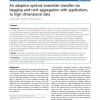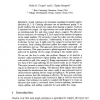335 search results - page 61 / 67 » A Model of User-Oriented Reduct Construction for Machine Lea... |
ESANN
2006
13 years 9 months ago
2006
Abstract. Response surfaces are a powerful tool for both classification and regression as they are able to model many different phenomena and construct complex boundaries between c...
IMC
2010
ACM
13 years 5 months ago
2010
ACM
Previous methods of network anomaly detection have focused on defining a temporal model of what is "normal," and flagging the "abnormal" activity that does not...
SIGIR
2008
ACM
13 years 7 months ago
2008
ACM
Many ranking models have been proposed in information retrieval, and recently machine learning techniques have also been applied to ranking model construction. Most of the existin...
BMCBI
2010
13 years 7 months ago
2010
Background: Generally speaking, different classifiers tend to work well for certain types of data and conversely, it is usually not known a priori which algorithm will be optimal ...
CC
1998
Springer
13 years 7 months ago
1998
Springer
Graph coloring is the dominant paradigm for global register allocation [8, 7, 4]. Coloring allocators use an interference graph, Z, to model conflicts that prevent two values from ...


